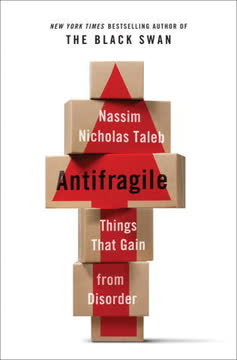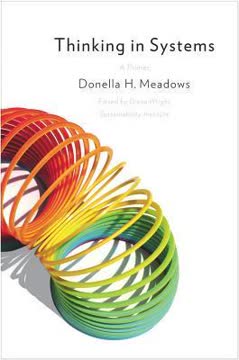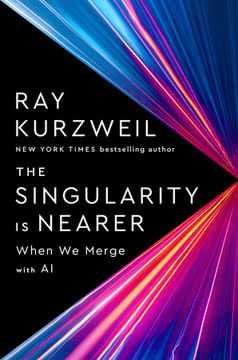Key Takeaways
1. Obliquity: The paradox of achieving complex goals indirectly
Obliquity describes the process of achieving complex objectives indirectly.
Indirect paths to success. Obliquity is the counterintuitive idea that in complex systems, goals are often best achieved indirectly. This principle applies to various domains, including personal happiness, business success, and problem-solving. For example:
- The Panama Canal follows a southeasterly direction to connect the Atlantic and Pacific oceans, rather than the seemingly more direct east-west route.
- Great cathedrals like Notre Dame were built over centuries through constant adaptation, not by following a single grand design.
- Successful businesses like ICI and Boeing thrived when they focused on broader objectives like "the responsible application of chemistry" or "eating, breathing, and sleeping the world of aeronautics," rather than narrow profit targets.
Obliquity recognizes that complex objectives are often imprecisely defined, contain incompatible elements, and are best achieved through a process of experimentation and discovery.
2. The pursuit of happiness: Why direct approaches often fail
Happiness is not achieved through the frequent repetition of favorable experiences, and that is why the pursuit of happiness is a peculiar phrase.
Paradoxical nature of happiness. The direct pursuit of happiness often leads to unhappiness, while engaging in challenging activities or focusing on others can bring greater fulfillment. This counterintuitive principle is demonstrated by:
- Mountaineers like Reinhold Messner, who find deep satisfaction in enduring extreme hardship
- The concept of "flow" described by psychologist Mihalyi Csikszentmihalyi, where people experience optimal enjoyment in demanding activities that fully engage their skills
- Parents who report that raising children was the best experience of their lives, despite the day-to-day challenges and reduced reported happiness
Happiness is best understood as a multi-layered concept, including momentary pleasure, overall life satisfaction, and eudaimonia (a sense of flourishing or living well). Achieving higher levels of happiness often requires embracing difficulty and focusing on goals beyond personal pleasure.
3. Profit-seeking paradox: How the most profitable companies are not the most profit-oriented
The responsible application of chemistry not only created a better business than did the attempts at creating value: It also created more value.
Oblique paths to profitability. Companies that focus primarily on maximizing shareholder value often underperform those with broader, more inspiring missions. This paradox is illustrated by numerous examples:
- ICI's success when focused on "the responsible application of chemistry" vs. its decline when prioritizing shareholder value
- Boeing's dominance under Bill Allen's leadership, emphasizing "eating, breathing, and sleeping the world of aeronautics"
- Johnson & Johnson's enduring success guided by its "credo" prioritizing responsibilities to customers, employees, and communities above shareholder returns
The most successful businesses often pursue complex, multifaceted objectives that balance the needs of various stakeholders. This oblique approach to business leads to greater innovation, employee engagement, and customer loyalty, ultimately resulting in superior long-term financial performance.
4. The art of the deal: Why the wealthiest people are not the most materialistic
The richest men are not the most materialistic.
Wealth as a byproduct. Many of the world's wealthiest individuals achieved their success not through a direct pursuit of money, but as a consequence of their passion for building businesses or solving problems. This principle is exemplified by:
- John D. Rockefeller, who viewed his ability to make money as "a gift from God" to be used for the good of mankind
- Sam Walton, who focused on building "the finest retailing company" rather than creating personal wealth
- Warren Buffett, who lives modestly and finds satisfaction in his skill as an investor rather than in material possessions
The most successful wealth creators often display:
- A passion for their business or field of expertise
- A focus on creating value for others
- A willingness to reinvest in their businesses or give back to society
This oblique approach to wealth creation contrasts sharply with the direct pursuit of money, which often leads to short-term thinking, unethical behavior, and ultimately, less financial success.
5. Complexity and incompleteness: Why the world resists direct solutions
Problems whose solutions require us to predict the future cannot, even in principle, be completely closed.
Limitations of direct approaches. The complexity and incompleteness of real-world problems often render direct, analytical approaches ineffective. This is due to several factors:
- Incomplete information: We rarely have all the data needed to fully understand or predict outcomes
- Changing environments: The context in which decisions are made is constantly evolving
- Multiple, conflicting objectives: Real-world goals are often multifaceted and not easily reducible to a single metric
- Unpredictable interactions: The consequences of our actions depend on the responses of others and complex system dynamics
Examples of failures due to overly direct approaches include:
- The collapse of Long-Term Capital Management, despite its sophisticated risk models
- The Iraq War, based on flawed assumptions and incomplete understanding of the region
- The 2008 financial crisis, driven by overreliance on simplistic risk assessments
Successful problem-solving in complex environments requires an oblique approach that embraces uncertainty, adaptation, and continuous learning.
6. Adaptation trumps design: The power of evolutionary approaches
Evolution is smarter than you are.
The wisdom of adaptation. In complex systems, adaptive processes often produce better outcomes than top-down design. This principle is evident in various domains:
- Biology: The intricacy and effectiveness of evolved organisms surpass human design capabilities
- Economics: Decentralized market systems consistently outperform centrally planned economies
- Business: Companies that adapt to changing conditions outperform those with rigid, top-down strategies
Key aspects of adaptive approaches include:
- Iterative improvement: Small changes tested over time
- Decentralized decision-making: Leveraging local knowledge and feedback
- Diversity: Maintaining a variety of approaches to increase resilience
Examples of successful adaptation include:
- The development of the Boeing 747, which evolved through numerous iterations and incorporated insights from many teams
- The success of companies like Honda, which adapted their strategies based on market feedback rather than following a predetermined plan
Embracing adaptive approaches allows organizations and individuals to navigate complex, uncertain environments more effectively than relying on rigid, pre-planned solutions.
7. The limits of rationality: Embracing inconsistency and tacit knowledge
We know more than we can tell.
Beyond explicit reasoning. Traditional notions of rationality, based on consistent preferences and explicit reasoning, fail to capture the full range of human decision-making capabilities. Key insights include:
- Tacit knowledge: Experts often make effective decisions without being able to fully articulate their reasoning
- Inconsistency as strength: The ability to hold contradictory ideas and adapt to changing contexts can be a sign of intelligence
- Emotions as information: Feelings like anger or fairness can provide valuable input to decision-making processes
Examples of the power of tacit knowledge and apparent irrationality:
- David Beckham's ability to "bend" a football without understanding the underlying physics
- Expert paramedics making rapid, effective decisions based on pattern recognition rather than explicit rules
- The success of oblique approaches in complex negotiations and social interactions
Recognizing the limits of explicit rationality allows for more nuanced, effective decision-making in complex real-world situations.
8. Muddling through: The effectiveness of iterative problem-solving
Obliquity is a process of experiment and discovery.
The power of incremental progress. In complex environments, an iterative, experimental approach often yields better results than comprehensive planning. Key aspects of "muddling through" include:
- Successive limited comparison: Evaluating options incrementally rather than comprehensively
- Learning by doing: Gaining understanding through action and experience
- Flexibility: Willingness to adapt goals and methods as new information emerges
Examples of successful muddling through:
- The development of the U.S. Constitution through debate, compromise, and subsequent amendments
- The iterative design process used in modern software development (agile methodologies)
- Franklin D. Roosevelt's approach to the New Deal, characterized by "bold, persistent experimentation"
This approach is particularly effective when dealing with:
- Ill-defined problems
- Changing environments
- Multiple stakeholders with conflicting interests
By embracing uncertainty and learning from experience, muddling through allows for more robust and adaptable solutions to complex problems.
9. The danger of spurious rationality: When good decision-making is confused with process
Franklin's gambit is why we use models in which most of the numbers are made up and that can be reworked to generate any desired outcome.
The illusion of rationality. Many organizations confuse good decision-making with adherence to formal processes, leading to "spurious rationality." This phenomenon is characterized by:
- Overreliance on quantitative models with unreliable inputs
- Post-hoc justification of decisions already made (Franklin's gambit)
- Emphasis on consistency and process over adaptability and judgment
Examples of spurious rationality in action:
- The use of sophisticated risk models that failed to predict or prevent the 2008 financial crisis
- Government policies justified by cost-benefit analyses manipulated to support predetermined conclusions
- Corporate strategy documents that provide a veneer of rationality to decisions driven by politics or intuition
The dangers of spurious rationality include:
- Overlooking important qualitative factors
- Suppressing valuable dissenting opinions
- Creating a false sense of security and control
Effective decision-making requires recognizing the limits of formal analysis and embracing the role of judgment, experience, and adaptability in navigating complex environments.
Last updated:
FAQ
What's "Obliquity: Why Our Goals Are Best Achieved Indirectly" about?
- Indirect Achievement: The book explores the concept that goals are often best achieved indirectly rather than through direct pursuit. This approach is termed "obliquity."
- Complex Objectives: It argues that complex objectives, such as happiness or business success, are often achieved through indirect means.
- Real-World Examples: The author, John Kay, uses various real-world examples from business, politics, and personal life to illustrate how oblique strategies can lead to success.
- Philosophical and Practical Insights: The book combines philosophical insights with practical advice, challenging conventional wisdom about goal-setting and achievement.
Why should I read "Obliquity: Why Our Goals Are Best Achieved Indirectly"?
- Challenge Conventional Thinking: It challenges the traditional notion that direct approaches are always the best way to achieve goals.
- Broaden Perspective: The book provides a broader perspective on decision-making and problem-solving, applicable to various aspects of life.
- Practical Applications: Readers can apply the concept of obliquity to improve personal and professional decision-making.
- Engaging Stories: The book is filled with engaging stories and examples that make complex ideas accessible and relatable.
What are the key takeaways of "Obliquity: Why Our Goals Are Best Achieved Indirectly"?
- Indirect Paths to Success: Success in complex areas is often achieved through indirect paths rather than direct approaches.
- Complexity and Uncertainty: The world is too complex and uncertain for direct methods to always be effective.
- Adaptation and Iteration: Successful problem-solving often involves adaptation, iteration, and learning from experience.
- Value of Obliquity: Embracing obliquity can lead to more effective decision-making and better outcomes in various fields.
What is the concept of "obliquity" as explained by John Kay?
- Definition: Obliquity is the idea that complex goals are often best achieved indirectly.
- Examples: The book provides examples from business, such as how companies like ICI and Boeing achieved success through indirect means.
- Philosophical Basis: The concept is rooted in the understanding that objectives are often imprecise and multifaceted.
- Practical Implications: It suggests that focusing on broader objectives rather than specific targets can lead to better results.
How does John Kay illustrate the "profit-seeking paradox"?
- Paradox Explanation: The paradox is that the most profitable companies are not necessarily the most profit-oriented.
- Company Examples: Kay uses examples like ICI and Boeing, which succeeded by focusing on broader goals rather than just profit.
- Oblique Strategies: These companies achieved profitability through oblique strategies, such as innovation and customer satisfaction.
- Long-Term Success: The paradox highlights that long-term success often comes from pursuing a range of objectives, not just financial ones.
What are some real-world examples used in "Obliquity" to illustrate its concepts?
- Business Success: Companies like ICI and Boeing are discussed as examples of achieving success through indirect means.
- Historical Events: The book references historical events, such as Napoleon's campaigns, to illustrate the unpredictability of direct strategies.
- Personal Fulfillment: Stories of individuals like mountaineer Reinhold Messner show how personal goals are often achieved obliquely.
- Economic Systems: The book discusses how market economies outperform planned economies through decentralized, indirect processes.
What role does complexity play in the concept of obliquity?
- Complex Systems: The book argues that complex systems are too intricate for direct approaches to be effective.
- Unpredictable Interactions: Interactions within complex systems are often unpredictable, requiring adaptive strategies.
- Iterative Learning: Success in complex environments often involves iterative learning and adaptation rather than fixed plans.
- Indirect Solutions: Oblique approaches are better suited to navigate the complexities and uncertainties of real-world problems.
How does "Obliquity" relate to decision-making and problem-solving?
- Iterative Process: Decision-making is often an iterative process that involves adapting to new information and circumstances.
- Limited Options: The book suggests that focusing on a limited set of options can lead to better decision-making.
- Judgment and Experience: Effective problem-solving relies on judgment and experience rather than rigid adherence to rules.
- Oblique Decision-Making: Embracing obliquity in decision-making can lead to more innovative and effective solutions.
What are the best quotes from "Obliquity" and what do they mean?
- "Goals are often best achieved without intending them." This quote encapsulates the central thesis that indirect approaches can lead to success.
- "We know more than we can tell." This highlights the importance of tacit knowledge and intuition in decision-making.
- "Evolution is smarter than you are." It suggests that adaptive processes can yield better results than planned strategies.
- "The route to profit was an oblique one." This emphasizes that financial success often comes from pursuing broader objectives.
How does John Kay address the concept of rationality in "Obliquity"?
- Rationality Redefined: The book challenges traditional notions of rationality, suggesting that it involves more than logical processes.
- Tacit Knowledge: Rational decision-making often involves tacit knowledge and intuition, not just explicit reasoning.
- Complexity and Uncertainty: Rationality must account for the complexity and uncertainty inherent in real-world problems.
- Oblique Rationality: The book proposes that oblique approaches can be more rational than direct methods in complex situations.
How can the concept of obliquity be applied to personal life?
- Personal Goals: Individuals can achieve personal goals more effectively by focusing on broader objectives rather than specific targets.
- Adaptation and Flexibility: Embracing adaptation and flexibility can lead to personal growth and fulfillment.
- Indirect Paths: Pursuing indirect paths can open up new opportunities and lead to unexpected successes.
- Life Satisfaction: The book suggests that life satisfaction often comes from pursuing meaningful activities rather than direct pursuit of happiness.
What are the limitations of direct approaches as discussed in "Obliquity"?
- Oversimplification: Direct approaches often oversimplify complex problems, leading to ineffective solutions.
- Lack of Flexibility: Rigid adherence to direct methods can hinder adaptation and innovation.
- Unintended Consequences: Direct strategies can lead to unintended consequences due to the complexity of real-world systems.
- Misguided Focus: Focusing solely on specific targets can distract from broader, more meaningful objectives.
Review Summary
Obliquity receives mixed reviews, with an average rating of 3.64 out of 5. Readers appreciate the book's central idea that complex goals are often best achieved indirectly. Many find the concept thought-provoking and applicable to various aspects of life and business. However, some criticize the writing style as repetitive and lacking in practical advice. The book draws comparisons to works by Malcolm Gladwell and Nassim Nicholas Taleb, with readers praising its engaging examples but noting that it could have been more concise and focused.
Similar Books








Download PDF
Download EPUB
.epub digital book format is ideal for reading ebooks on phones, tablets, and e-readers.







